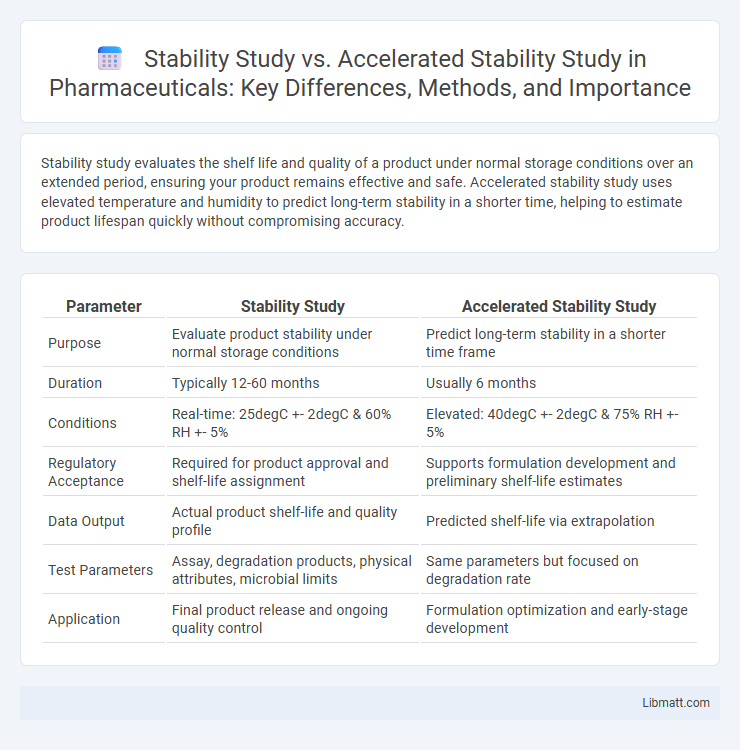Stability study evaluates the shelf life and quality of a product under normal storage conditions over an extended period, ensuring your product remains effective and safe. Accelerated stability study uses elevated temperature and humidity to predict long-term stability in a shorter time, helping to estimate product lifespan quickly without compromising accuracy.
Table of Comparison
| Parameter | Stability Study | Accelerated Stability Study |
|---|---|---|
| Purpose | Evaluate product stability under normal storage conditions | Predict long-term stability in a shorter time frame |
| Duration | Typically 12-60 months | Usually 6 months |
| Conditions | Real-time: 25degC +- 2degC & 60% RH +- 5% | Elevated: 40degC +- 2degC & 75% RH +- 5% |
| Regulatory Acceptance | Required for product approval and shelf-life assignment | Supports formulation development and preliminary shelf-life estimates |
| Data Output | Actual product shelf-life and quality profile | Predicted shelf-life via extrapolation |
| Test Parameters | Assay, degradation products, physical attributes, microbial limits | Same parameters but focused on degradation rate |
| Application | Final product release and ongoing quality control | Formulation optimization and early-stage development |
Introduction to Stability Studies
Stability studies assess the chemical, physical, and microbiological characteristics of pharmaceutical products over time under specified storage conditions to ensure safety and efficacy. Accelerated stability studies expose products to elevated stress conditions such as higher temperature and humidity to quickly predict shelf life and identify degradation pathways. Both studies are critical components of regulatory submissions and quality control in drug development, providing essential data for labeling and storage recommendations.
Defining Standard Stability Studies
Standard stability studies assess the physical, chemical, microbiological, and biopharmaceutical properties of a drug product under long-term storage conditions, typically at 25degC and 60% relative humidity, over a period of 12 to 36 months. These studies provide critical data on the shelf-life, recommended storage conditions, and expiration dating of pharmaceuticals based on controlled, consistent environmental settings. In contrast, accelerated stability studies expose the product to elevated stress conditions, such as 40degC and 75% relative humidity, for shorter durations to quickly predict long-term stability trends and identify potential degradation pathways.
Understanding Accelerated Stability Studies
Accelerated stability studies simulate long-term storage conditions by exposing pharmaceutical products to elevated temperatures and humidity, allowing faster prediction of product shelf life and degradation patterns. These studies help identify potential stability issues, ensuring quality, efficacy, and safety without waiting for prolonged periods typical of traditional stability studies. Regulatory guidelines from the ICH outline specific conditions for accelerated testing to support accelerated product development and approval processes.
Key Differences Between Stability and Accelerated Stability Studies
Stability studies assess the quality, safety, and efficacy of a product under normal storage conditions over its entire shelf life, providing real-time data. Accelerated stability studies simulate stress conditions such as elevated temperature and humidity to predict the product's shelf life in a shorter period. Your choice depends on whether you need long-term data or rapid insights into product stability under extreme environments.
Objectives of Each Study Type
Stability study aims to evaluate the shelf life and physical, chemical, and microbiological integrity of a pharmaceutical product under recommended storage conditions, ensuring its safety and efficacy throughout its intended lifespan. Accelerated stability study seeks to predict product stability by exposing it to elevated stress conditions such as higher temperatures and humidity, thereby estimating degradation rates and potential shelf life more quickly. Both studies are essential for regulatory submissions, with stability studies providing real-time data and accelerated studies offering rapid insights into product robustness.
Regulatory Guidelines and Compliance
Regulatory guidelines for stability studies require real-time data collected under recommended storage conditions to ensure product safety and efficacy throughout its shelf life. Accelerated stability studies, designed to simulate longer periods in a shorter time by using elevated temperatures or humidity, must comply with regulatory frameworks such as ICH Q1A(R2) to validate predictive models. Your documentation must clearly differentiate and align both studies to meet compliance standards for product approval and ongoing quality assurance.
Methodology and Testing Conditions
Stability study involves testing a pharmaceutical product under recommended storage conditions, typically at 25degC and 60% relative humidity, to assess its shelf-life over an extended period. Accelerated stability study exposes the product to elevated stress conditions such as 40degC and 75% relative humidity to quickly predict long-term stability and identify potential degradation pathways. Your choice between these methods depends on the product development timeline and regulatory requirements for ensuring drug efficacy and safety.
Data Interpretation and Shelf-life Prediction
Stability study data interpretation relies on real-time monitoring of a drug's physical, chemical, and microbiological properties under recommended storage conditions, providing direct evidence of product shelf-life. Accelerated stability study uses stress conditions like elevated temperature and humidity to predict shelf-life faster, requiring extrapolation models such as the Arrhenius equation to estimate long-term stability. Combining data from both studies enhances shelf-life prediction accuracy by validating accelerated test results against real-time stability outcomes.
Challenges and Limitations
Stability studies often face challenges such as long durations and resource intensity, making timely data collection difficult for product lifecycle management. Accelerated stability studies overcome time constraints but may introduce limitations due to altered environmental conditions that can affect the accuracy of long-term stability predictions. Your ability to interpret accelerated data critically is essential to ensuring reliable product performance throughout its intended shelf life.
Conclusion: Choosing the Appropriate Stability Study
Selecting the appropriate stability study depends on the specific objectives of the pharmaceutical development process and regulatory requirements. Stability studies provide real-time data under recommended storage conditions, ensuring product quality throughout its shelf life, while accelerated stability studies offer rapid insights by exposing products to elevated stress conditions to predict long-term stability. Balancing the need for thorough, real-time data with faster results, pharmaceutical companies often use accelerated studies for early screening and long-term stability studies for final validation.
Stability study vs accelerated stability study Infographic

 libmatt.com
libmatt.com